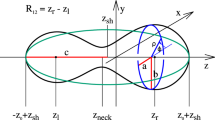Abstract
Nuclei colliding at energies in the MeV’s break into fragments in a process that resembles a liquid-to-gas phase transition of the excited nuclear matter. If this is the case, phase changes occurring near the critical point should yield a “droplet” mass distribution of the form ≈A −T, with T (a critical exponent universal to many processes) within 2≤T≤3. This critical phenomenon, however, can be obscured by the finiteness in space of the nuclei and in time of the reaction. With this in mind, this work studies the possibility of having critical phenomena in small “static” systems (using percolation of cubic and spherical grids), and on small “dynamic” systems (using molecular dynamics simulations of nuclear collisions in two and three dimensions). This is done investigating the mass distributions produced by these models and extracting values of critical exponents. The specific conclusion is that the obtained values of T are within the range expected for critical phenomena, i.e. around 2.3, and the grand conclusion is that phase changes and critical phenomena appear to be possible in small and fast breaking systems, such as in collisions between heavy ions.
Similar content being viewed by others
References
A.D. Panagiotou et al., Phys. Rev. Lett. 52 (1984) 496.
A.S. Hirsh et al., Phys. Rev. C29 (1984) 508.
G.F. Bertsch and P. Siemens, Nucl. Phys. A314 (1984) 465.
A.L. Goodman, J.I. Kapusta and A.Z. Mekjian, Phys. Rev. C30 (1984) 851.
A.S. Hirsch et al., Phys. Rev. C29 (1984) 508.
D.H.E. Gross, Phys. Rep. 279 (1997) 119.
J. Kapusta, Phys. Rev. C29 (1984) 1735.
J. López and P. Siemens, Nucl. Phys. A314 (1984) 465.
V. Serfling et al., Phys. Rev. Lett. 80 (1984) 3928.
J. Pochodzalla et al., Phys. Rev. Lett. 75 (1995) 1040.
M. Belkacem, V. Latora and A. Bonasera, Phys. Rev. C52 (1995) 271.
M. Kleine Berkenbusch et al., Phys. Rev. Lett. 88 (2002) 022701; W. Bauer et al., Heavy Ion Phys. 15 (2001) 217.
D.H. Youngblood, C.M. Rozsa, J.M. Moss, D.R. Brown and J.D. Bronson, Phys. Rev. 39 (1977) 1188.
J.A. López and C.O. Dorso, Lecture Notes in Phase Transformations in Nuclear Matter, World Scientific, Singapore, 2000.
L.D. Landau and E.M. Lifshitz, Statistical Physics, 3rd Ed., Part 1. Pergamon Press Ltd., New York, 1980.
M.E. Fisher, Critical Phenomena, Proceedings of the International School of Physics “Enrico Fermi” Course 51, ed. M.S. Green, Academic, New York, 1971, p. 1.
C.O. Dorso and J.A. López, Phys. Rev. C64 (2001) 027602.
T. Li et al., Phys. Rev. C49 (1994) 1630.
L. Phair, W. Bauer and C.K. Gelbke, Phys. Lett. B314 (1993) 271.
D. Stauffer and A. Aharony, Introduction to Percolation Theory, Taylor and Francis, London, 1992.
A. Barranón, A. Chernomoretz, C.O. Dorso and J.A. López, Rev. Mex. Fis. 45(S2) (1999) 110.
C.O. Dorso and J. Randrup, Phys. Lett. B301 (1993) 328; C.O. Dorso and J. Aichelin, Phys. Lett. B345 (1995) 197; T. Reposeur, F. Sebille, V. de la Mota and C.O. Dorso, Z. Phys. A357 (1997) 79.
A. Strachan and C.O. Dorso, Phys. Rev. C55 (1997) 99; ibid. C58 (1998) R632; ibid. C59 (1999) 285.
A. Barranón, A. Chernomoretz, C.O. Dorso and J.A. López, Rev. Mex. Fis. 45(S2) (1999) 110.
R.J. Lenk, T.J. Schlagel and V.R. Pandharipande, Phys. Rev. C42 (1990) 372; R. Lenk and V.R. Pandharipande, Phys. Rev. C34 (1986) 177; T.J. Schlagel and V.R. Pandharipande, Phys. Rev. C36 (1987) 162.
A. Barrañón, C.O. Dorso and J.A. López, Rev. Mex. Fis. 47(S2) (2001) 93.
Author information
Authors and Affiliations
Rights and permissions
About this article
Cite this article
Barranón, A., Cárdenas, R., Dorso, C.O. et al. The critical exponent of nuclear fragmentation. APH N.S., Heavy Ion Physics 17, 59–73 (2003). https://doi.org/10.1556/APH.17.2003.1.8
Received:
Issue Date:
DOI: https://doi.org/10.1556/APH.17.2003.1.8




